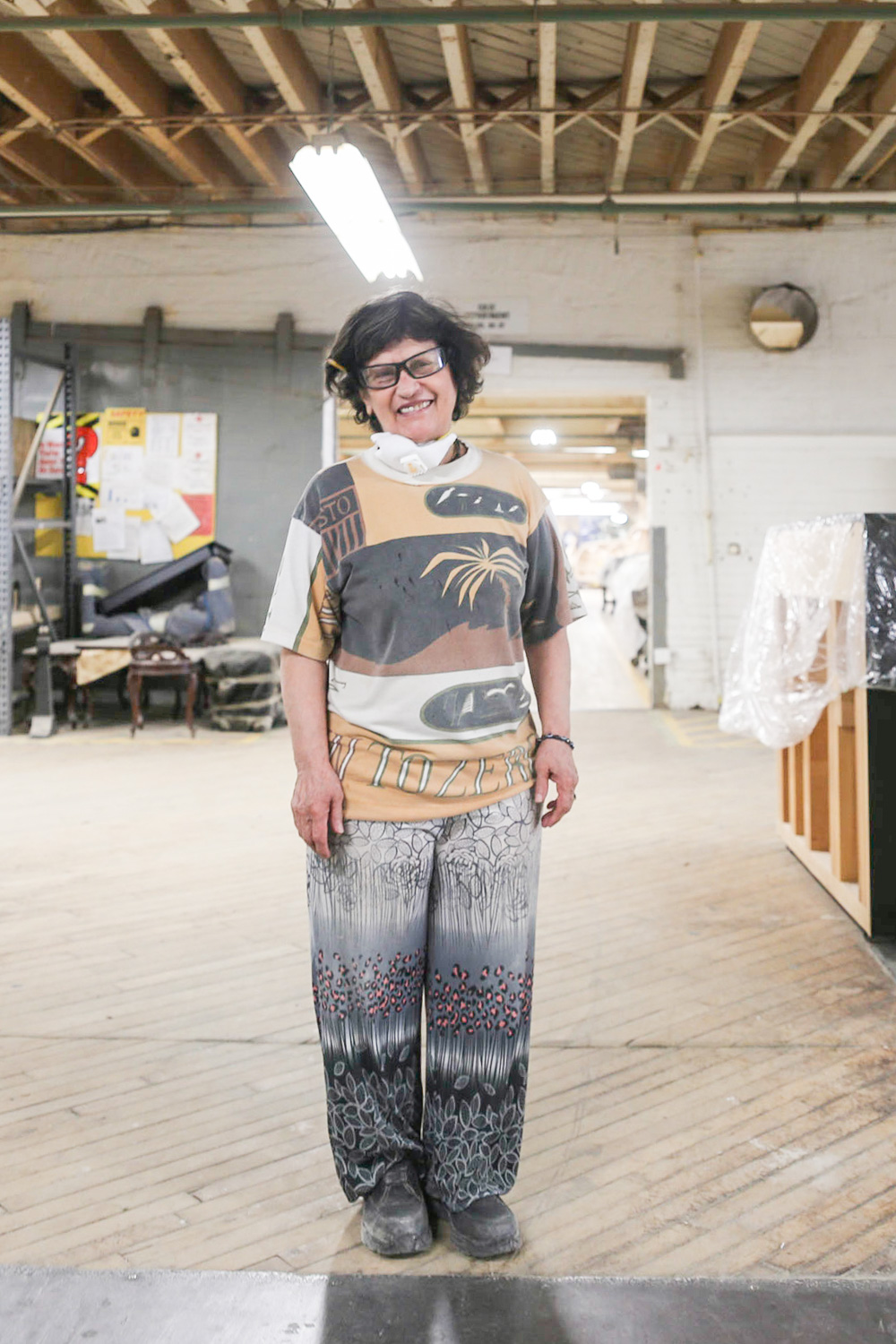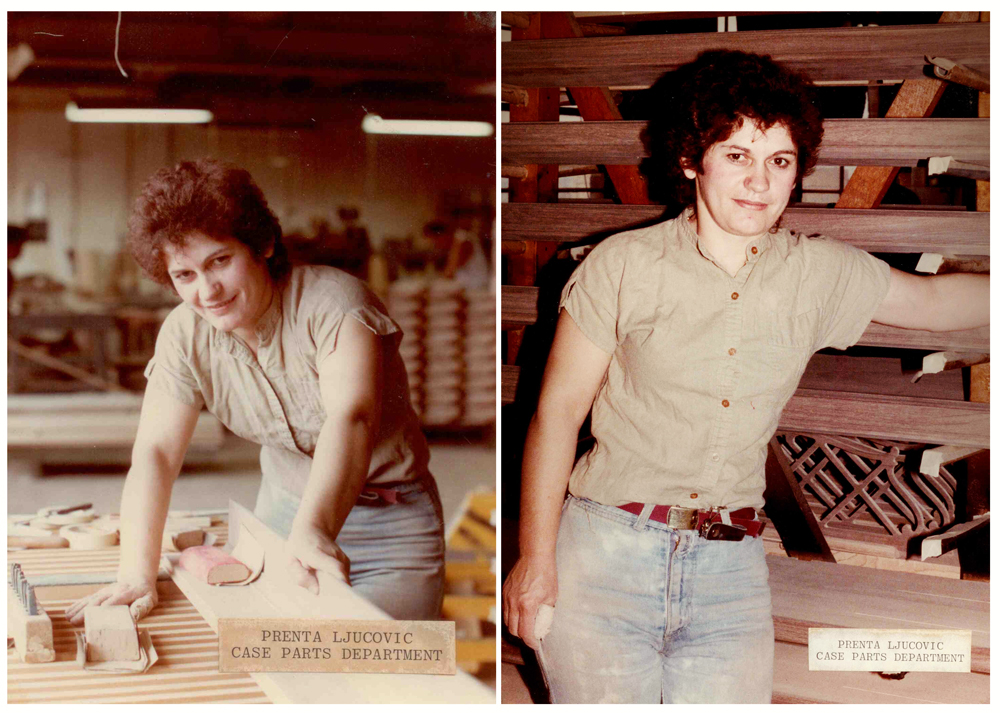Prenta Ljucovic Reigns As Steinway’s Only Female Case-Maker
In January 1973, Steinbrenner bought the Yankees, Nixon started his second term, and a subway ride to Queens cost $0.35. And in the cold, battered streets of the Bronx—a borough that would soon prompt the infamous “Bronx is burning” declaration that summed up the violent socioeconomic unrest of parts of New York City in the seventies—a young woman walked. She was cold. She was nervous. Her English was weak, and she was missing the family she’d left behind in Montenegro when she and her brother arrived in New York a month earlier, looking for work. But she kept walking, headed for the train that would bring her across the East River to the Steinway & Sons factory, where she would begin her first day of work in the case-making department.
Her name was Prenta Ljucovic, and today, more than four decades later, she still walks through the factory doors each morning and heads for case-making. She’s a little older, sure, and a little wiser. She also now owns the double distinctions of being the longest-tenured woman in the factory and the only woman who has ever served in the arduous and demanding role of a Steinway & Sons case-maker.
“I’m making the best pianos in the world. And I love them. Every single one of them, I love.”
She’s come a long way. From the poverty-stricken streets of early-seventies Bronx, Prenta now owns a home in New Hyde Park. She works out, plays guitar, and travels back to Montenegro regularly to visit her family. It’s a good life, she says. “I came here from a poor country; my brother and I came because the United States is the United States. It was the best country we could come to. I wanted to see if I could get a job and have a better life, like many people do.” She pauses and considers her statement. “I think whatever I was asking for, so far I’ve gotten,” she continues. “I’m making the best pianos in the world. And I love them. Every single one of them, I love.”
 Photo: Arthurious
Photo: Arthurious
The longevity of Prenta’s career with Steinway is something she shares with a select group of men and women who have made it past the thirty-, forty-, and sometimes even fifty-year mark at the factory. She’s been working at Steinway through the terms of eight U.S. presidents and through the breakup of her home country Yugoslavia and its reformation into successor states. She’s built cases through the fall of Saigon, the invention of the mobile phone, the unification of Germany, the launch of the Hubble space telescope, and the horrors of 9–11. But to hear Prenta tell it, “it feels like forty days, not forty years. I really do enjoy what I do, and I cannot believe I’ve actually been here this long. It’s going to be very tough when the day comes to retire.”
“I Like To Work With Wood”
Case-making is a job that might not suit some women. It involves lifting heavy blocks of solid spruce, which is no small feat to cut, plane, sand, drill, and shape. When Prenta begins her work on the case of a Steinway grand, the instrument is still the barest skeleton, just an empty rim constructed of layered laminations of hard-rock maple. The rim has been bent and wrestled into shape by a team of specialists using essentially the same procedure C. F. Theodore Steinway devised in the 1870s. The rim has been planed and perfected and has been sitting in a conditioning room for more than a month. And now it comes to Prenta, who will use various species of wood to create and install the rest of the cabinetry that will comprise the piano’s outer case, which is the piano’s most visible feature and the element that encapsulates nearly all of the instrument’s 12,000 parts.
“I like the physical satisfaction of building, of working with my hands. It’s a joy.”
The rim is wheeled over to Prenta’s area. She approaches it with pieces of spruce and begins the process of planning for the braces, trusses, and dowels. Soon she’s hoisting heavy pieces of wood, layering thick coatings of glue, and handling drills as long as her arm. For Prenta, it’s all in a day’s work. “For some reason I like to work with wood,” she says simply. “Maybe it’s because I got started very young, I don’t know. I just like the physical satisfaction of building, of working with my hands. It’s a joy.”
The House Of Prenta
Ask any of the men she works with, and the answer is the same: working with Prenta is a joy in itself. Take Santé Auriti, for example. Santé is one of the most well-known artisans in the case-making department. He’s been known to take the show on the road with exhibition-style gigs making Steinway piano cases in high-visibility locations—including the window of Steinway Hall on West 57th Street—for people to see the exquisite craftsmanship that goes into a case. He’s spent twenty-five years working with Prenta, and he has a simple assessment of her talents: “She’s one of the greatest workers we have,” he says. “Sometimes I think without her here, none of us would know what to do.”
Her skill, he points out, lies not just in her workmanship, though she has indeed perfected a three-hundred-year-old craft in which few people in the world gain true proficiency. It lies also in her ability to instill in the team a sense of ownership and accountability for the finished product that’s a true hallmark of the Steinway & Sons brand. “Prenta is the last one here every night,” Santé says. “She walks around this place turning out lights, tidying up details. This factory is like her house. We’re all very proud to work for Steinway. But for Prenta, there’s something more. Put it this way: her car is the last one in the lot at night. She loves her work that much.”

Vincent Skeete agrees. He’s been with Steinway for forty-three years and has worked alongside Prenta in the case-making department for the majority of that time. “Prenta is unusual,” he says. “Some people politely come to work and get the job done. But she comes to work because she truly loves her job. It’s a very inspiring thing to see.”
Vincent is quick to point out that Prenta’s gender has had no bearing on her production levels or her abilities. “Listen, she’s no slacker,” he says. “I’d put her abilities up against any man in the factory, including my own. It’s amazing. She just doesn’t get tired.” He pauses for a moment, then laughs as a thought occurs to him. “Maybe it’s because she doesn’t eat junk like the rest of us,” he says. “She takes care of herself. She exercises. She has integrity.”
She also has resilience, if her four-decade tenure is any indication. But for Prenta, there’s no sign of slowing down any time soon. “My supervisor John Marek says I’m not allowed to retire until after he does,” she says, smiling. “So I don’t know what the future will hold. Right now I feel good and I feel healthy and strong. I would love to go on for as long as I can, but if I see that I cannot keep producing the way I want to, then I will have to consider making a change. If I don’t make a good piano, I’m wasting time. But so far, so good. I just want to continue to build the best pianos in the world. It’s been a great career. I’m very lucky.”